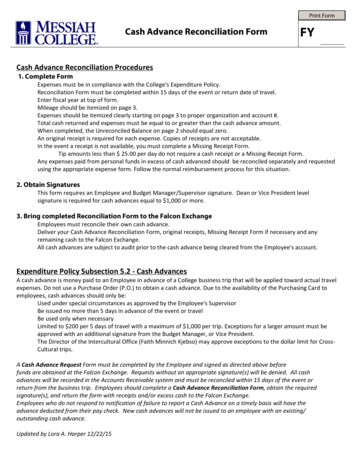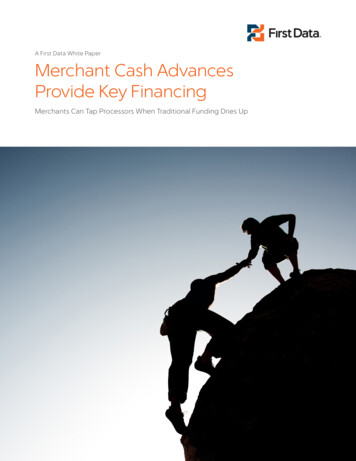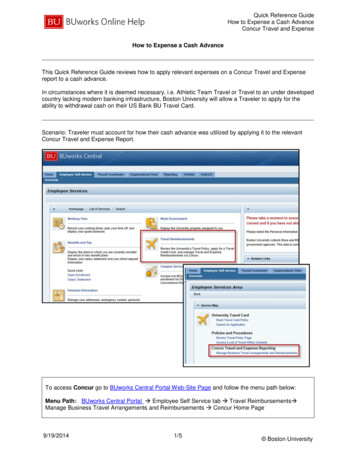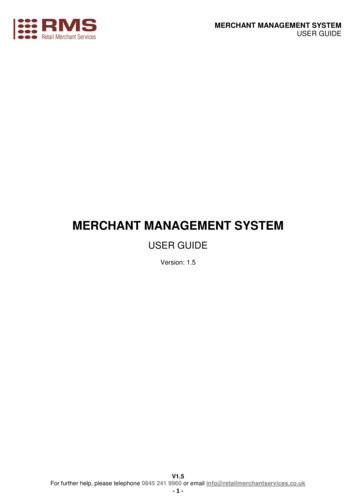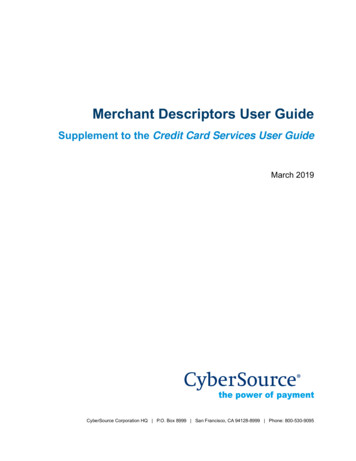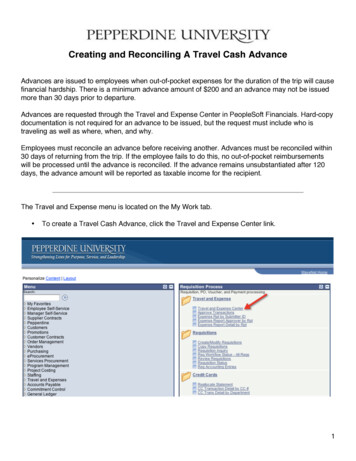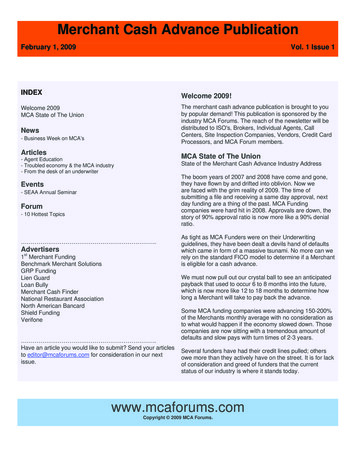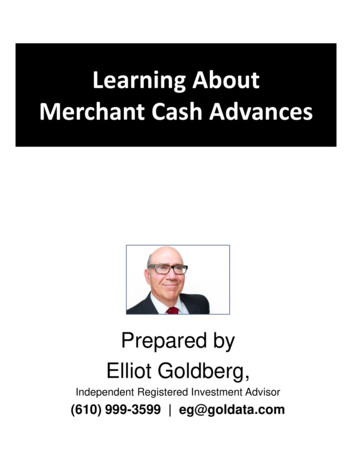
Transcription
Merchant Cash Advance / Small Business FinancingIndustry ReportJanuary 2016
DisclaimerThis publication has been prepared by Bryant Park Capital LLC (―BPC‖) for informational purposes only. The information contained within thepublication has been obtained from sources that BPC believes to be reliable, but BPC does not represent or warrant that it is accurate or complete.BPC is not responsible for, and makes no warranties whatsoever as to, the content contained within the publication or the content of any third-partyweb site accessed via a hyperlink in this publication and such information is not incorporated by reference.The publication is being provided confidentially and neither the publication nor any of the information contained within can be shared ordisseminated in any way without the express written approval of BPC. By receiving this publication, Recipient accepts and acknowledges that allinformation contained within is the sole property of BPC, and that neither Recipient nor anyone within Recipient’s organization is authorized toreproduce or disseminate the content of the publication. Recipient acknowledges that monetary damages may not be a sufficient remedy forunauthorized disclosure or use of the publication, and that BPC may seek, without waiving any other rights or remedies, such injunctive or equitablerelief as may be deemed proper by a court of competent jurisdiction for any disclosures of the publication.Joel MagermanManaging Partner & nt Park Capital2489 Fifth Avenue16th FloorNew York, NY 10017161 Washington StreetSuite 310Conshohocken, PA 19428
Table of ContentsI.Market OverviewII. Company CharacteristicsIII. Industry PlayersIV. Industry ConsiderationsV. M&A and Capital RaisingVI. What’s next: 2016Appendix A.Financing Considerations in ISO ParticipationAppendix B.Sources3
Section IMarket Overview
Market OverviewIndustry Description The Merchant Cash Advance (―MCA‖) Industry evolved out of the challenges small businesses faced accessing capital to grow. An MCA is typically a short-term cash advance given to small and medium-sized businesses (―SMB‖) as a purchase of a fixed amount ofreceivables due sometime in the future. There are several variations to the concept of an MCA, but many MCAs share several corecharacteristics: Payments are either collected from a portion of an SMB’s bank account via Automated Clearing House (―ACH‖) or via a split paymentdirected by credit card sales directly from its merchant processor on a daily, weekly, or monthly basis.– Payments can either be a fixed percentage of a SMB’s sales or a fixed nominal amount, usually paid on a daily basis. From a regulatory perspective, typical MCAs are not considered to be loans, therefore they are not subject to the same laws that applyto loans. However, this lack of regulation may change over time, and as the industry grows many of the larger market participants areadding lending products to their portfolio of product offerings. Additionally, many market participants are adding loan products to the traditional MCA marketplace to expand their marketopportunity. These MCA providers developed a unique set of credit/underwriting criteria and collections and innovative term and payment collectiontechnology. They do not rely on traditional financial statements in the underwriting process and often social media, bank statements and NSFmanagement as by underwriting criteria. Approval turnaround times for getting an MCA range from a day to under a week from submitting an application to receiving the advance.MCAs are faster, require less paperwork, are more readily accessible, and are approved more easily and frequently than traditional bank loans.Industry average approval rates are approximately 46%. The typical SMB customer uses the cash advance for quick working capital purposes—from purchasing new equipment to coveringoperational costs and more. Independent Sales Organizations (―ISOs‖) typically play a significant role in providing MCA providers with merchants looking for a shortterm advance. These ISOs often service the merchants for their credit card processing and are now able to offer an MCA as an add-onproduct. However, the origination business for advances has become so lucrative that many ISOs focus almost exclusively on MCAopportunities. Typically about 50% of MCA financings come from ISOs.5
Market OverviewOverview of a Merchant Cash AdvanceDaily ACHs to MCAMerchantBroad SolicitationISORequest for FundingFunding Request LeadProvides Funds to Merchant6Pays CommissionMCAUnderwritesprices andfunds; servicesand collects
Market OverviewISOs Most MCA funders generate leads internally and through third party ISOs. It is estimated that 50% of total MCA originations were generated by ISOs and provided to MCA funders for one-time commissions. MCA providers are also building or buying in-house origination capabilities. In excess of 1,000 ISOs compete for leads to ―sell‖ to the MCAs. In an effort to promote strong potential transaction flow from ISOs, MCA funders are increasingly providing opportunities for ISOs to―participate‖ (i.e. invest) in a percentage of the merchant funding transaction (loan or advance) originated (typically up to 50% of the advanceamount). The larger more successful ISOs also often provide the ability to ―White Label‖ the MCA under their name to appear as thefunding entity to the borrower. Over the past 6-12 months ISOs are seeing a growing opportunity to invest in these lucrative participation opportunities; however, most ISOsface capital constraints that limit their capacity to invest.Source Funding Leads from MerchantsISOPay 5%-10% commissionInvest in Percentage of Sourced Deal via―Participation‖ Merchant/Small Business7MCA
Market OverviewHistory of the MCA Industry The inception of the industry is disputed, but the general consensus is that the MCA industry started a little after the widespread popularityof credit cards in the late 1990s. AdvanceMe (currently operates under the name of CAN Capital), which is widely considered to be the first MCA provider, wasfounded in 1998 in Georgia.1 Early MCAs resembled loans and included clauses requiring personal guarantees. As the industry evolved, industry players shifted away fromloan-like documentation and made MCAs predominately non-recourse and removed personal guarantee requirements.2 The North American Merchant Advance Association (―NAMAA‖) was founded on April 15, 2008 with the goal of setting standards for theMCA industry.3 NAMAA rebranded itself as the Small Business Finance Association (―SBFA‖) on April 14, 2015 and currently has 17 members.These members include many of the larger market participants. After the credit crisis of the late 2000s, SMBs experienced even more challenging borrowing requirements at banks due to increasedregulatory restrictions for lending to small businesses, including Dodd Frank and Basel III. This led to increased demand for MCAs whichhas remained consistent through today and is expected to remain at high levels for the foreseeable future.4 In recent years, many of the larger MCA providers have increasingly focused on differentiating themselves from traditional MCAs—lumpsum payments for a portion of future sales taken as a fixed percentage of daily sales—and the associated stigma and negative reputation.They have added products like lines of credit, more traditional loan-like products, lengthened payback periods, and reduced rates to expandthe market opportunity. Many of the larger MCAs have taken advantage of the large amount of data they have collected over the years tofurther segment their customer base and offer different products, reflecting lower rates and/or longer payback periods to qualified customers.8
Market OverviewSize and Growth of Small Business Lending Excluding real estate, the total value of U.S.-small business loans under 1 million was 297.9 billion, as of June 2014, a decline of 28.8billion from 326.7 billion in 2007.5 Demand for small business loans from the U.S. Small Business Administration (―SBA‖) has spiked in 2015.6,7 The SBA’s 7(a) small business lending program was suspended in July 2015 after the U.S. hit its loan volume cap of 18.75 billion.– 9Approximately 1.7 billion of the loans issued by the 7(a) program were loans under 150 thousand.President Obama signed a measure in late July 2015 to raise the SBA’s 7(a) small business lending program loan volume cap to 23.5billion, in order for the program would remain operational throughout the fiscal year.
Market OverviewSize and Growth of Small Business Lending (cont.) 10The modern-day, post-credit crisis banking environment has lead to continued growth in the MCA industry.8,9 As of August 2015, traditional big banks offered a 22 percent approval rate of small business loans as compared with a 49 percentapproval rating by small banks. However, the number of small banks has decreased by approximately 28 percent between 2000 and2014. Regulatory restrictions and costs of compliance with such restrictions for large financial institutions remain deterrents for traditionalbanks to provide small dollar lending.
Market OverviewSize and Growth of the MCA Industry The size of the MCA industry varies based on different sources and the definition of an MCA. While some sources strictly define MCAs asthe purchase of future receivables with payments taken as a fixed percentage of credit card sales at the point of sale, other sources defineMCAs more broadly to include unsecured small business loan-type instruments that require daily, weekly, or monthly funding.10,11, 12 Converge Enterprise (a leading Cloud CRM company that has customized its CRM application to offer the world’s first CRMdeveloped exclusively for the business cash advance, business loan, and merchant processing industry) estimates that there are morethan 1,500 MCA funders, each with relationships with approximately three to 20 ISOs, and a combined annual lending volume ofover 10 billion as of September 2014. Sean Murray of deBanked estimates that the daily funding industry, which he defines as a combination of MCA providers and lendersthat require daily payments, is approximately 3-5 billion per year as of August 2014.Payment processors, such as PayPal, Square, and Intuit have also begun to expand into providing MCAs and working capital loans for theSMBs with which they already do business.13,14,15 PayPal provided over 500 million in SMB loans and advances to 40,000 SMBs between January 2014 and August 2015. Square has provided, on average, 1 million per day in advances to SMBs in 2015. In September 2015, OnDeck partnered with Intuit to launch QuickBooks Financing, a new 100 million small business lending fundthat offers a daily funding product. OnDeck (NYSE:ONDK) became the first standalone MCA funder to go public. OnDeck originated 1.7B of advances/loans in its last 12months as of the end of Q3 2015 and has a market cap of 621.81M at of 1/5/2016.16, 17 Additionally, at least five MCA funders have sold/received investments from private equity firms in the past 24 months.11
Market OverviewBryant Park Capital Annual Funding Estimate for MCA/SMB Financing Industry Estimates for 2014 and 2015 take into account total dollars funded by respondents to the Bryant Park Capital/deBanked Small BusinessFinancing CEO Survey (the ―Survey‖); additional public data on fundings by companies not included in the survey; and an assumption forthe percentage of industry fundings that is not included in those figures. Projections for 2016 and 2017 represent a 20% annual growth rate, which is based on the lower end of projections by CEOs in the Survey.12
Section IICompany Characteristics
Company CharacteristicsTypical Borrower Profile Typical borrower is a small merchant; common industries include:RetailServicesClothingAmusement and recreationFood and groceryAuto repair and maintenanceFloristsCleanersFurniture and appliancesDentistsHardware and home improvementRestaurants and barsLiquor storesSalons Has a diversified customer base Has some operating history, typically at least one year Has significant and consistent activity through a bank account Has meaningful amount of business processed with credit cards Owner has a personal credit history with a FICO score (although FICO score is not necessary a determining factor) Has a social media presence on Facebook, Yelp, and other sites showing a following14
Company CharacteristicsRange of Types of Product Structures While there are a variety of different products offered in the MCA market, all products have common core characteristics, including: Short-term funding to SMBs– Daily, weekly, or monthly remittances to the MCA providers Unsecured and non-recourse– Typically an advance as a factoring arrangement, i.e. buying the right to the proceeds of future receivables Less frequently a loan, but loans with daily repayments are becoming more common Underwriting process does not heavily weigh credit scores of applicantsDifferences in product structures mainly depend on payment structure: 15Typically less than 12 months, although the duration of new products is expanding to 18-24 months for credit worthyborrowersPayments are either collected from a fixed nominal portion or fixed percentage of a SMB’s credit card sales directly from itsprocessing terminal or directly from the SMB’s business bank account on a daily, weekly, or monthly basis until the fixed amount ispaid off.
Company CharacteristicsGeneral Deal Process Origination MCA funders either originate advances from their ISO relationships or from internal or direct marketing methods.– MCA internal sales teams usually solicit existing customers for renewal advances.Underwriting 16Approximately 50% of originations come from each method.Due diligence requirements include:–Bank statements (3-6 months)–Minimum monthly credit/debit card sales volume–Minimum age of company–Maximum rent-to-sales ratio–Submission of a number of monthly processing and business bank data including overdraft statements–May require use of certain POS terminals–Social Media: Yelp, Facebook–Site visits – usually outsourced to an third-party provider
Company CharacteristicsGeneral Deal Process Financing MCA funders were initially funded by high yield hedge funds, then by lower yielding credit opportunities funds, and eventually bybanks (particularly for the larger, more established funders). Banks, having chosen largely to exit SMB lending due to regulatory andcost issues, have found lending to MCA providers to be more efficient and more profitable. These banks have selectively entered thespace, providing warehouse facilities and more recently partnering with MCA funders (OnDeck & JP Morgan). Today, mature MCA providers typically obtain senior debt financing from institutional lenders at interest rates ranging from 3.5-7.0%and advance rates ranging from 80-90% of the advanced amount. In addition, a number of these more mature organizations haveobtained mezzanine capital, bringing the total advance rate to approximately 90-95% of the advanced amount.–Key determinants for advance rate and interest rate include: Static pool data Default rates by industry, size, geography, years in business, FICO score, and other meaningful attributes Overall business results Operating, underwriting, servicing, and financial systems Seasonality of merchants Sponsor-backedThe remaining portion of the advance is funded by junior debt or equity.Servicing 17Operating history, particularly:MCA funders maintain contact with borrower and manage customer service & collections.–Often offers renewal deals for good performing clients (most profitable & sought after business)–For delinquent/defaulted transactions, the funder (or sometimes an outside third party servicer) is responsible for collections
Company CharacteristicsSingle Unit Analysis The following table shows the economics of a sample MCA transaction with an advance of 10,000 and a factor rate of 1.35x. Right to receive (―RTR‖) or payback is the amount owed/purchased by the MCA provider and is calculated as advance multiplied byfactor rate. Credit loss is calculated as a percent of principal, and this analysis assumes a loss rate of 6.5%. Sales commissions are paid upfront as a percent of principal advanced, and this analysis assumes a rate of 10.0%. Blended cost of capital is based on a combination of senior debt and more expensive junior debt. Since the advance and therefore thelines of debt are paid down on a daily, weekly, or monthly basis, and advances are typically paid back over a period of nine months orfewer, the weighted cost of capital per transaction ends up equating to far less than the annual rate. This analysis assumes a weightedcost of capital of 10.0% annually. This analysis assumes a daily payback over a nine month period, which yields a net IRR of 47.9% after the aforementioned costs butbefore G&A.MCA Single Advance AnalysisAdvanceFactor RatePayback/RTR 10,0001.35x 13,500Credit Loss (on Principal)Gross Amount Received (Post Loss)( 650) 12,8506.5%Sales CommissionsCost of Capital (Weighted)Net Amount Received( 1,000)( 269) 11,58110.0%10.0%Term (Months)Term (Weekdays)Net IRR189.0180.047.9%
Section IIIIndustry Players
Industry PlayersTop Players in MCA IndustryTop CompaniesOnDeckCAN CapitalKabbageBusiness Financial ServicesMerchant Cash and Capital / BizFiMerchants Capital AccessRapid AdvanceNational FundingTop Equity Investors20Top Debt ProvidersAngelo GordonCapitalSourceRockbridge Growth EquityFortress CreditPalladium Equity PartnersVictory Park CapitalPine Brook PartnersWells Fargo Capital FinanceCapital Z Partners Management, LLCAres ManagementAccel PartnersAtalaya Capital ManagementFlexpoint FordComvest PartnersThomvest VenturesH.I.G. Whitehorse
Industry PlayersKey Industry PlayersCompany NameInceptionYearHQProductsOfferedAdvance Funds Network2007Brooklyn, NY MCA, invoice &PO factoring,term loansNew York, MCA, term loansNYAmerican Express MerchantFinancing2011American Finance Solutions(Acquired by Rapid CapitalFunding)AmeriMerchant* (Capify)2006Anaheim, CAMCA2002New York,NYMCA, term loansBFS (Business FinancialServices)*2002CAN Capital1998Capital for Merchants*2005Troy, MICredibly (formerlyRetailCapital)*2010Troy, MIElevate Funding*2015Gainseville,FLLoan SizeRepaymentPeriod 5,000 - 10M 10,000 - 2M 5,000 - 1MCoral Springs,MCA, term 4,000 - 2MFLloans, franchisefinancingNew York, MCA, term loans 5,000 - 150,000NYMCATime to FundImmediately uponapproval 250M 5.9M2 days 500M 41.1M5 - 10 days1 day21All information gathered from publically available information9-18 months 1B 5B MCA, term loan 5,000 - 250,000* member of the SBFA, formerly known as the NAMAA6-24 months12 hours3 days 200,0002014 Revenue 252M 2,000 - 500,000MCA Funded SinceInception2-5 days 269.9M 220M3-12 months 140M 14.6M
Industry PlayersKey Industry Players (cont.)InceptionYearEverest Business Funding2013Fora Financial*2008New York,NYMCA, term loans 5,000 - 250,0001-3 daysForwardLine2003WoodlandHills, CAMCA, term loans 5,000 - 150,0001 day6-12 monthsGRP Funding*2007Springfield,MAMCA, term loans 5,000 - 1M1 day4-24 monthsHappy Rock MerchantSolutions*2008New York,NYMCA 2,500 - 300,0005-10 daysKabbage2008Atlanta, GA MCA, term loans 2,000 - 100,000Merchant Advance FundingLP*2009New York,NYMerchant Capital Source*2005Huntington MCA, term loans 5,000- 500,000Beach, CAMerchant Cash & Capital*(now Bizfi)2005New York,NYCompany NameHQProductsOfferedLoan SizeTime to FundMiami, FLMCA 5,000 - 500,0001 dayMCAMCARepaymentPeriod1 day6 months3-4 days5-14 months1 day3 months- 10years Funded SinceInception2014 Revenue 350M 26.9M 250M 1B 40.1M 1.3B 27M 10,000 - 125,000 5,000 - 500,000* member of the SBFA, formerly known as the NAMAA22All information gathered from publically available information
Industry PlayersKey Industry Players (cont.)Company NameInceptionYearHQProductsOfferedMerchants Capital Access*2009Melville, NY MCA, term loansNational Funding1999San Diego, CANextWave Funding*2010Miami, FLOn Deck Capital(NSE:ONDK)2006New York,NYTerm LoansPayPal Working Capital2013San Jose, CAMCAPearl Capital2006New York,NYMCA, ISOpartnershipsPrincipis Capital*2009New York,NYMCAQuick Bridge Funding2011Irvine, CAMCARapid Capital Funding2007Miami, FLLoan SizeTime to FundRepaymentPeriod 250,0003 - 5 days3-24 monthsMCA, term 500,000loans, equipmentleasingMCA, term loans 5,000 - 500,000 5,000 - 250,000MCA, term loans 5,000 - 500,000* member of the SBFA, formerly known as the NAMAA23All information gathered from publically available information 1B1 day1 day2-7 Days2014 Revenue 39M1-3 days 1,000 - 85,000 Immediately uponapproval 4,000 - 150,000 Funded SinceInception 100M 3-24 months 3B 158.1M 1B 145M 44.6M5-7 days 400M 1M- 2.5M
Industry PlayersKey Industry Players (cont.)InceptionYearHQProductsOfferedLoan SizeTime to FundRapidAdvance*2005Bethesda, MDMCA, term loan 5,000 - 500,0003 - 10 daysSquare Capital2014San Francisco,CAMCA, term loan 1,000 - 100,000Sterling Funding2005Tampa, FLMCA, term loan 5,000 - 250,000Strategic Funding Source*2006Swift Capital*2007Wilmington,DEMCA 5,000 - 300,0001 hour - 3 daysYalber*2007Teaneck, NJMCA 500,0002-3 days 500MYellowstone Capital (Fundry)2009New York, NYMCA 1 day 1.1BCompany NameNew York, NY MCA, term loans24All information gathered from publically available information Funded SinceInception2014 Revenue 750M 225M2-7 days 5,000 - 1M* member of the SBFA, formerly known as the NAMAARepaymentPeriod3-12 months6-10 months 700M3-12 months 450M 27.5M
Section IVIndustry Considerations
Industry ConsiderationsU.S. Regulatory Landscape Dodd Frank18,19 Increased bank regulation leads to increased compliance costs, forcing many community banks to scale back lending activities, with adisproportionate reduction in small business lending.–Community banks shed 12 percent of their share of the U.S. banking assets since the passage of Dodd Frank in 2Q 2010.–The smallest community banks, with under 1 billion in assets, shed 19 percent of their share of U.S. banking assets in thesame time.Basel III (to be implemented by 2019)20 The introduction of a leverage limit of three percent and a 30-day liquidity coverage ratio could potentially lead to reduced traditionallending particularly affecting small business. Increased capital requirements, especially for Tier 1 capital (for which loans to many small businesses do not meet), may adverselyimpact the cost of traditional lending.Operation Choke Point 21 Regulators increased the responsibility/accountability for potentially fraudulent activities funded by banks and would hold the Boardof Directors and management directly liable for these activities.–26Moreover, Operation Choke Point identifies many legal, but potentially reputationally risky industries, including alternativecredit programs such as MCAs, ―recommending‖ that the larger banks not lend to these industries.
Industry ConsiderationsMCA Legal Historical Snapshot 272007 AdvanceMe Patent Lawsuit 22 AdvanceMe sued several MCAs, including but not limited to AmeriMerchant and RapidPay, over its patent on the concept of a MCA. The court ruled against AdvanceMe, citing that the idea of an MCA had been done before by companies such as Dining Ala Card. Assuch, AdvanceMe’s patent was invalidated and prevented a potential legal monopoly.2011 Richard B. Clark v. AdvanceMe (California)23,24 Merchant plaintiffs (Richard B. Clark et al.) sued AdvanceMe, arguing that the receivables required to pay down their cash advanceswas exorbitant. Plaintiffs further argued that the receivables required were effectively interest payments, and in fact far exceeded animplied effective annual interest rate of 100 percent. AdvanceMe had also required collateral in the form of personal guarantees andpersonal property. The court ruled in favor of Richard B. Clark, citing that AdvanceMe’s MCAs were ―disguised loans,‖ and thus violated California’susury laws. AdvanceMe settled for 23.4 million and forfeited its right to pursue further repayments from plaintiffs. The case was notalone; it was merely the hallmark case for a string of cases against the MCA business model. These lawsuits spurred many MCA providers to become licensed lenders in states where the court cases ruled against the MCAproviders. Moreover, many MCA providers enacted policy changes—such as the removal of collateral requirements—to furtherdistinguish MCAs from loans.
Industry ConsiderationsChallengesCredit Market Challenges: MCA providers may be adversely affected by disruptions in the credit market.25 MCA providers rely on debt facilities and other forms of borrowings to finance advances to customers. As the volume of advancesincreases, MCA providers must find ways to expand current borrowing capacities. There is no guarantee of additional fundingsources.–Interest rate spreads may also decline in the future as the market becomes more competitive, which will have a major impacton profitability.Underwriting Challenges: Historical default rates are not indicative of future performance. Any increase in future default rates will reduce profitability and attractivenessto institutional lenders. Current default rates run between approximately 6-10% based on the quality of the merchants. However, default ratesgot close to 20% during the great recession. At that time, it is estimated that close to 33% of MCA providers went out of business. At thosedefault rates, similar risks exist. Underwriting relies heavily on self-reported documents from customers—algorithms may not calculate all associated risks with providing aMCA.Competitive Market Challenges: Traditional banks, payment processors (PayPal, Square, etc.), and other related companies (Amazon) are starting to enter the MCA industrywith their own specialty finance lending groups, increasing competition and squeezing margins.26 Regulatory uncertainty may shape the relatively new MCA market and brings about additional legal risks. Marketing efforts need to vigorously dispel general market stigma against MCAs thought to be usurious.28
Industry ConsiderationsStacking Stacking is the practice of providing a MCA to a SMB, knowing that the SMB is currently financed by one or more MCAs. The SBFA is anti-stacking, viewing it as a threat to the recovery of money advanced to SMBs and as a threat to the overall health of theSMBs taking out advances.27 Other MCA providers argue that SMBs with sufficient cash flow should have the right to take on as many MCAs as they feel comfortabletaking. Below are the results from the Bryant Park Capital/deBanked Small Business Financing CEO Survey regarding the sentiment on stacking:29
Section VM&A and Capital Raising
M&A and Capital RaisingKey Transactions in the Small Business Lending SpaceDateTargetInvestor(s)Amount( mm)Type10/14/2015Fora FinancialPalladium Equity PartnersN/AEquity10/1/2015Yellowstone Capital(Fundry)FinsightN/AEquity9/25/2015BFS CapitalNoneN/AIPOannouncment8/16/2015Entrust Merchant Solutions Business Financial ServicesN/AM&A7/24/2015KabbageBlueRun; Thomvest Ventures; UPS; Santander 120.0Equity7/23/2015DealstruckCommunity Investment Management LLC 10.0Equity7/15/2015Strategic Funding SourceCapitalSource 90.0Debt7/9/2015Pearl Capital, LLCCapital Z Partners Management, LLC 60.0M&A6/30/2015The Business Backer, LLCEnova International, Inc. (NYSE:ENVA) 26.8M&A6/26/2015Snap AdvancesUndisclosed 28.0Equity31All information gathered from publically available information
M&A and Capital RaisingKey Transactions in the Small Business Lending Space (cont.)Amount( mm)DateTargetInvestor(s)6/16/2015Credibly (formerly RetailCapital)AloStar Bank of Commerce, WebBank, Capital Source N/ADebt6/5/2015Reliant Services Group,LLCMerchants Capital Access, LLCN/AM&A5/12/2015Square CapitalVictory Park CapitalN/ADebt4/17/2015Plan B GrowthWorld Business Lenders, LLCN/AEquity4/14/2015Business BounceLendioN/AM&A4/9/2015ApplePie CapitalQED Investors, Signia Ventures Partners, FreestyleCapital 6.0Equity4/9/2015Funding CircleDST Global, Baillie Gifford, Sands Capital andTemasek 150.0Equity4/8/2015DealstruckUndisclosed 8.0Equity4/2/2015CAN Capital, Inc.Wells Fargo; AloStar; Amalgamated; Barclays; 650.0CapitalSource; Fifth Third; 1st Tennessee; J.P. Morgan;Morgan Stanley; Regions Bank; SunTrust; UBSDebt3/24/2015LendioNorth Hill Ventures, Blumberg Capital, Napier Park,Runa CapitalEquity32All information gathered from publically available information 20.0Type
M&A and Capital RaisingKey Transactions in the Small Business Lending Space (cont.)Amount( mm)TypeLightspeed Venture Partners, 83North, Silicon ValleyBank, Correlation Ventures 19.0EquityOnDeckN/A 200.0IPO12/3/2014MarketInvoiceNorthzone Ventures 8.0Equity11/20/2014FastPayOak HC/FT 15.0Equity11/14/2014FinexkapGLI Finance 8.0Equity10/28/2014SpotcapAccess Industries, Holtzbrinck Ventures 17.0Equity10/20/2014CreditSuppliersG8 Capital 13.0Equity10/8/2014American FinanceSolutions LLCRapid Capital FundingN/AM&A9/26/2014The Credit JunctionGLI Finance 2.0Equity9/12/2014GeldvoorelkaarTrustBuddy /201433All information gathered from publically available information
M&A and Capital RaisingKey Transactions in the Small Business Lending Space (cont.)DateTargetInvestor(s)Amount( mm)Type9/12/2014MarketInvoicePaul Foster, co-founder Indeed.com 8.0Equity9/3/2014Strategic Funding SourcePine Brook Partners 110.0Equity8/26/2014Business FinancialServicesWells Fargo Capital Finance 125.0Debt8/26/2014LeapPayFunding CircleN/AM&A8/23/2014Swift CapitalFortress Credit 50.0Debt8/21/2014BlueVineN/A 2.0Equity8/20/2014Credibly (formerly RetailCapital)Flexpoint FordN/AEquity8/1/2014Principis CapitalBMO HarrisN/ADebt7/31/2014National Fu
The Merchant Cash Advance (―MCA‖) Industry evolved out of the challenges small businesses faced accessing capital to grow. An MCA is typically a short-term cash advance given to small and medium-sized businesses (―SMB‖) as a purchase of a fixed amount of receivables due sometime in the future.
